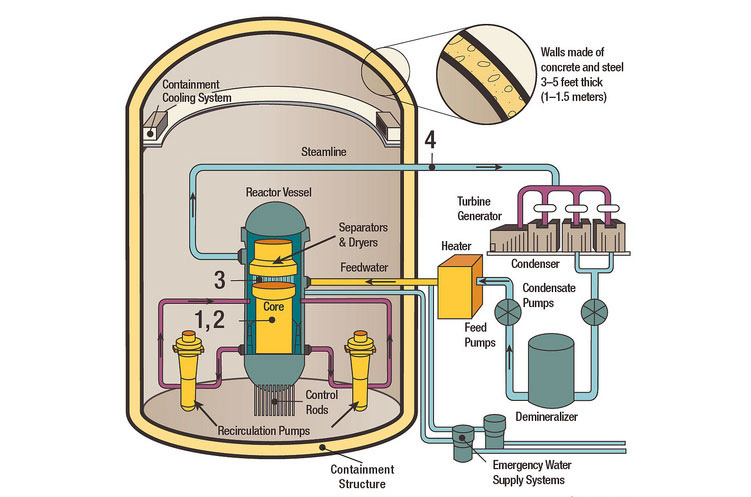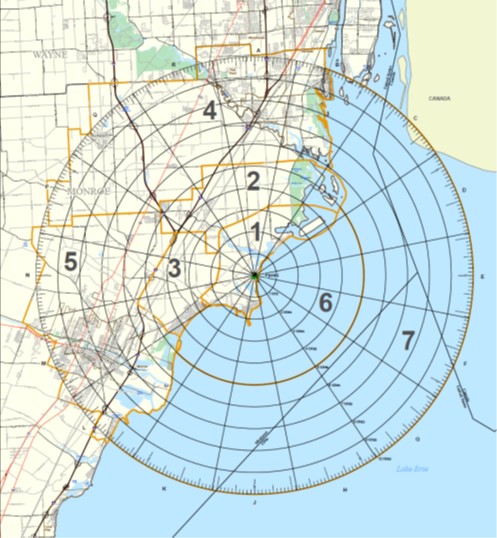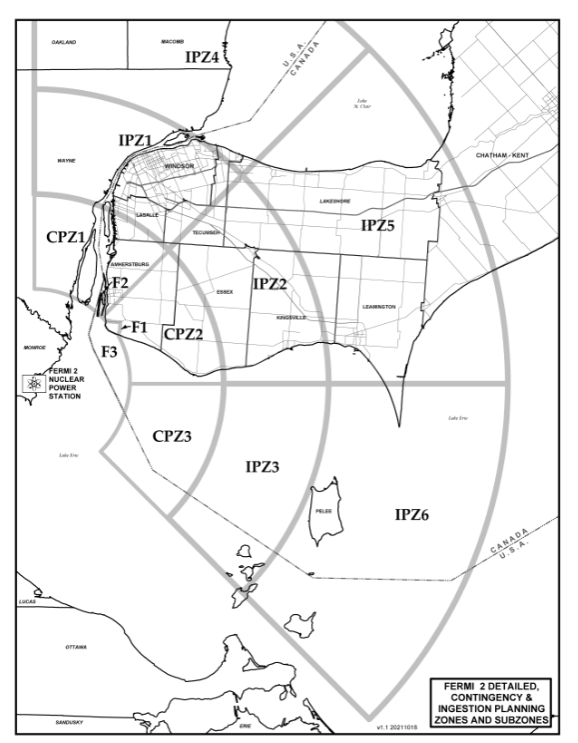Chapter 2: The planning basis
2.1 General
2.1.1 This implementing plan details the response to an emergency at the Fermi 2 Nuclear Power Plant (Fermi 2).
2.1.2 Fermi 2 is located at latitude 41° 58' north and longitude 83° 15' west, immediately to the north of Pointe Aux Peaux on the western shore of Lake Erie in Monroe County, Michigan, U.S.A. It is approximately 50 km southwest of Detroit.
2.1.3 The Fermi 2 reactor facility houses a General Electric Boiling Water Reactor (Unit 2) of 1093 MWe power with a pressure suppression Mark 1 containment. The site is also the location of the Fermi 1 reactor. Fermi 1 was an experimental fast-breeder reactor which was shut down in 1972 and has been undergoing decommissioning activities since that time.
2.1.4 Figure 2.1 shows a schematic diagram of a Boiling Water reactor.
2.1.5 Figure 2.2 shows the 10 (ten) mile Emergency Planning Zone and Protective Action Areas for the off-site response authorities in Michigan, USA. The Fermi 2 Protective Action Order Areas, Area 1-Area 7, correspond to default protective actions in Ontario (see Table 4.3).
2.2 The hazard
2.2.1 If an accident were to occur at Fermi 2, the most probable result would be that its effects would be confined within the station boundary because the containment system in the Fermi 2 reactor is of a high-pressure, low-leakage design intended to prevent any release of radioactivity following an accident.
2.2.2 Much less probable is a Design Basis Accident which would result in a low to moderate level of fuel damage combined with some form of containment failure within six to 24 hours (or more) of the occurrence of the accident.
2.2.3 Nuclear emergency preparedness requires a planning basis which considers both design basis accidents, and significantly less probable beyond design basis accidents, including severe accidents.
2.2.4 Design Basis Accidents
- The Design Basis Accidents release provides the main platform for detailed planning and is generally characterized by one or more of the following:
- Station containment systems function normally allowing radiation to start decaying prior to a controlled release.
- Sufficient time would be available to alert the public and implement protective measures prior to a release.
- The main radiological hazard to people would be external exposure to, and inhalation of, radionuclides.
- Filter systems function to remove almost all of the radioactive particulate and radioiodine. As a result, the plume would be mostly composed of inert noble gases which would dissipate and do not pose a contamination hazard.
- Radiation doses to the public would likely be below the generic criteria (GC) as defined in PNERP Master Plan, Annex E.
- Environmental contamination would be limited to very low levels.
- Low-level radioactive releases to the environment could occur on and off for some time (e.g., days or weeks).
- An example of a design basis accident scenario is a Loss-of-Coolant Accident with the following typical progression:
- The reactor building would "box-up" preventing any immediate releases. A "box-up" is a condition whereby all possible release pathways to the environment, such as ventilation stacks, are closed.
- The hold-up time in the reactor building would allow for decay of some short-lived radionuclides.
- If at any stage the pressure in the containment system nears atmospheric pressure, the contained radioactivity may be vented to the environment through a series of charcoal and HEPA filters that remove the majority of radioiodines and particulate radionuclides. Such venting could be intermittent or continuous but may last for weeks. The level of radioactivity being released would progressively decline with time.
- Suitable meteorological conditions may make it possible to vent some of this contained radioactivity through filters in a direction away from populated areas. It may be possible to do this several times.
2.2.5 Beyond Design Basis Accidents
- One or more of the following may define a Beyond Design Basis Accident:
- Station containment systems may be impaired leading to significantly reduced hold up time and decay of radioactive materials.
- An early release of radioactivity from a Beyond Design Basis Accident with limited warning time.
- An uncontrolled release of radioactivity from a Beyond Design Basis Accident with limited warning time.
- The plume could include radioiodine and particulates along with noble gases.
- Radiation doses could potentially be high e.g., greater than 250 mSv (25 rem) beyond the site boundary.
- Environmental contamination could be quantitatively significant in both extent and duration.
- The area affected could extend beyond the DPZ.
- Beyond Design Basis Accidents which go unmitigated may evolve into severe accidents involving fuel degradation in the reactor core.
- The response to Beyond Design Basis Accidents, including severe accidents, is facilitated by diverse and flexible mitigation strategies (e.g., FLEX equipment) in addition to the measures already in place to respond to DBAs (see 2.2.4 above) and the ability to expand their function.
- The following additional actions shall be conducted to mitigate the much less probable, but possibly more severe, off-site effects of Beyond Design Basis Accidents:
- Pre-distribution of Potassium Iodide (KI) pills (see Section 5.3.3)
- Automatic, default actions to initiate public alerting (see Section 6.2)
- Directing the implementation of protective actions, including sheltering-in-place (see Section 5.3.4) and evacuation (see Section 5.3.1) as appropriate and based on recommendations for protective actions from Fermi 2.
- Timely dispatch of aerial and ground monitoring teams to determine areas of contamination (see Section 4.7.3)
- Extension of protection actions to the Contingency Planning Zone (CPZ), if required, to reduce potential for exposure
- Radiation monitoring and, if necessary, decontamination of persons (see Section 6.9)
- Medical assessment, treatment and counselling as required (see Section 6.9)
2.2.6 Planning Times for Radioactive Emissions
- The time interval between the occurrence of an accident at Fermi 2 and the commencement of an emission depends on the condition and functioning of the station containment system and on the effectiveness and timing of the actions taken by station operators to prolonging the holdup and decay of radioactive material within containment.
- The containment system in the Fermi 2 reactor is designed to prevent any release of radioactivity to the environment following an accident. An emission would only occur if containment was impaired or bypassed. In such cases, radioactive emissions could commence within about six hours of the onset of the accident. The duration of the release, depending on the nature of the accident, could be from four to 24 hours.
- When controlled venting is required, intermittent filtered releases of varying durations could continue for many weeks.
- In the exceptional situation where the containment system was impaired, an emission could commence much earlier; in some cases, very soon after the accident and, the emission may be continuous.
2.3 Protective actions
2.3.1 The protective actions available for minimizing the radiation hazard in a nuclear emergency include:
- Precautionary measures
- Exposure control measures
- Ingestion control measures
2.3.2 These measures are listed in Table 2.1 below and defined in the glossary (Annex D).
2.3.3 The Office of the Fire Marshal and Emergency Management (OFMEM) shall coordinate, in advance, the development of a strategy for Fermi 2 protective action decision-making with appropriate stakeholders. The strategy shall consider the following:
- The timing and distance criteria for undertaking the Michigan-based exposure control protective measures throughout the emergency response.
- The timing and distance criteria for undertaking the Michigan-based ingestion control protective measures in the early stage of the emergency, prior to the availability of Ontario environmental field monitoring data and analysis.
- PEOC Scientific Section analysis of the Ontario environmental field monitoring results.
- The operational situation in Ontario within which protective actions are to be undertaken.
- Precautionary measures based on an assessment of all of the above.
2.3.4 Further detail is provided, as follows:
- Phases of a nuclear emergency response (Chapter 4)
- Protective action response strategy (Chapter 5)
- Operational response (Chapter 6)
2.3.5 Responsibility for decision-making and directing of protective actions rests primarily with the PEOC Commander (KI ingestion decisions and direction rest with the Chief Medical Officer of Health (CMOH)). All references in this Plan to these responsibilities shall be assumed to apply to both the PEOC Commander as well as any person that is delegated PEOC Commander responsibility.
Table 2.1 Protective actions for a nuclear emergency response
| Precautionary measures (see section 5.2) |
Exposure control measures | Ingestion control measures |
|---|---|---|
|
|
|
2.4 Planning Zones
2.4.1 Automatic Action Zone (AAZ)
- The AAZ is a pre-designated area immediately surrounding a reactor facility. As such, there is no AAZ designated for Fermi 2 because of the distance between the Fermi 2 reactor facility and the shoreline of Essex County (approx.15 km).
2.4.2 Detailed Planning Zone (DPZ)
- The DPZ is a pre-designated area surrounding a reactor facility where pre-planned protective actions are implemented as needed on the basis of reactor facility conditions, dose modelling, and environmental monitoring, with the aim of preventing or reducing the occurrence of stochastic effects.
- The Fermi 2 DPZ is the area immediately surrounding the reactor facility extending out to an approximate radius of 16 kilometres (10 miles) which is consistent with the United States Nuclear Regulatory Commission (U.S. NRC) regulation for U.S. reactor facilities' plume exposure pathway emergency planning zones.
- Although outside the 16km DPZ distance, Bois Blanc Island (commonly referred to as Boblo Island) has been included as a sector of the DPZ due to practical and logistical issues associated with an island evacuation. As such, in the event of an initial nuclear emergency notification from Fermi 2 resulting in the evacuation of the 16km sector, a precautionary evacuation of Bois Blanc (Boblo) Island should also be directed. However, as the emergency progresses and when time is available to undertake an assessment, the need for a Bois Blanc (Boblo) Island evacuation will be determined through consultation with applicable stakeholders, including the designated municipality.
- The DPZ for Fermi 2 is shown in Figure 2.3. The exact boundaries of the zone can be determined from Annex A.
2.4.3 Contingency Planning Zone (CPZ)
- The CPZ is a pre-designated area surrounding a reactor facility, beyond the DPZ (see 2.4.2 c) above), where contingency planning and arrangements are made in advance, so that during a nuclear emergency, protective actions can be extended beyond the DPZ as required to reduce potential for exposure.
- The Fermi 2 CPZ is shown in Figure 2.3 and includes the area between 16 and 32 kilometres surrounding the reactor facility.
- Additional CPZ guidance is provided in Annex C.
2.4.4 Ingestion Planning Zone (IPZ)
- This Fermi 2 IPZ (see Figure 2.4) is the area immediately surrounding the reactor facility extending out to an approximate radius of 80 kilometres (50 miles) which is consistent with the United States Nuclear Regulatory Commission (U.S. NRC) regulation for U.S. reactor facilities' ingestion exposure pathway emergency planning zones. Provincial plans and arrangements are undertaken for this area in order to:
- Protect the food chain
- Protect drinking water supplies
- Restrict consumption and distribution of potentially contaminated produce, wild-grown products, milk from grazing animals, rainwater, animal feed
Note: Wild-grown products can include mushrooms and game. - Restrict distribution of non-food commodities until further assessments are performed
- The Fermi 2 IPZ encompasses Essex County, the City of Windsor, and an area of Chatham-Kent lying within an 80 km radius of Fermi 2. The IPZ includes the DPZ and CPZ. Figure 2.4 also shows the sub-zones of the IPZ.
2.5 Response sectors
2.5.1 The DPZ for Fermi 2 is three sectors as follows
- Town of Amherstburg area - Sector F1
- Bois Blanc (Boblo) Island - Sector F2
- Lake Sector - Sector F3
2.5.2 The boundaries of the DPZ response sector are shown in Figure 2.3, and are detailed in Annex A.
2.6 Planning data, interface and support
2.6.1 Municipal planning data
Designated municipality nuclear emergency plans shall detail the planning data necessary to undertake an effective nuclear emergency response. This data should be organized according to planning zones, sub-zone and response sector, and include:
- Population estimates (see Annex B)
- Institutional data
- Critical infrastructure
2.6.2 Evacuation time estimates
- Evacuation time estimate studies shall be prepared by MTO and regularly updated to facilitate transportation planning and the management of transportation during a response.
- Evacuation time estimates shall be based on current census data and future population growth projections until end of life of the reactor facility and take into consideration shadow evacuations
footnote 2 . - The Town of Amherstburg shall provide planning data to assist MTO in the development of ETE studies.




Footnotes
- footnote[1] Back to paragraph Numbering system includes the letter 'F' to represent 'Fermi' and to distinguish the Ontario sector numbers from those used in Michigan.
- footnote[2] Back to paragraph "Shadow evacuation" is the term used to describe when people beyond the officially declared evacuation zone who are not directly affected by a nuclear emergency choose to voluntarily leave the area.
- footnote[3] Back to paragraph Nuclear Generating Unit Schematic — Boiling Water Reactor is a generic diagram. For more information on the design concept, including the numbers indicated on the diagram, visit: https://www.nrc.gov/reactors/bwrs.html
- footnote[4] Back to paragraph Reference: https://www.michigan.gov/documents/miready/FERMI_Guide_703714_7.pdf (PDF 1.3 MB)